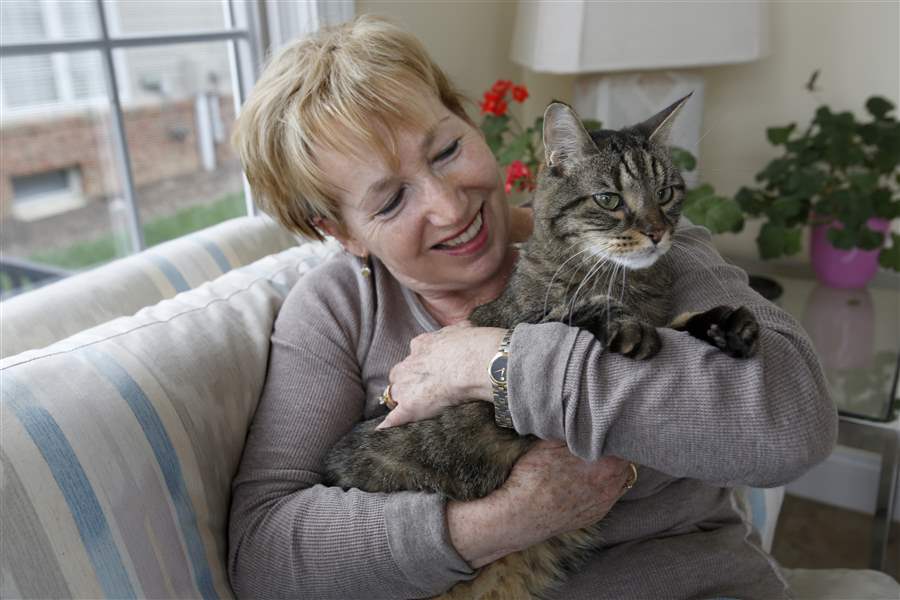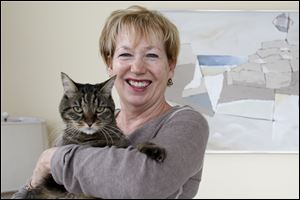
Diet helps calm tabby’s thyroid issues
Medication, radioiodine commonly treat disorder
5/14/2013
Sylvania resident Marna Ramnath’s 16-year-old tabby, Twist, has been living with hyperthyroidism for two years now. Ms. Ramnath said a modified diet has done wonders for the cat’s condition.
THE BLADE/KATIE RAUSCH
Buy This Image

Sylvania resident Marna Ramnath’s 16-year-old tabby, Twist, has been living with hyperthyroidism for two years now. Ms. Ramnath said a modified diet has done wonders for the cat’s condition.
It really does make a difference what you eat. Marna Ramnath’s cat Twist’s hyperthyroidism is under control because of a special diet.
Twist, a 16-year-old gray tabby, was diagnosed two years ago with an overactive thyroid gland, which is fairly common among aging cats, says Dr. Jen Tate, a veterinarian at SylvaniaVET who has been Twist’s doctor for many years.
He had extremely high blood-thyroid-hormone levels and a rapid heart rate, so surgery was recommended, said Ms. Ramnath. The procedure, a partial thyroidectomy, improved his condition only slightly, so he was started on medication — methimazole.
“The medication didn’t give good control, either,” said Ms. Ramnath, of Sylvania. “His blood levels fluctuated from very high to very low with the slightest of adjustments in dosage.”
The cat continued on the medication, but when a new Hill’s Science Diet prescription food specifically for hyperthyroidism came out last year, Dr. Tate suggested they put Twist on it.
The food limits the cat’s uptake of iodine, which is a building block of thyroid hormone.
“We were skeptical that diet alone could control what surgery and medication couldn’t, but decided to try it at Dr. Tate’s recommendation,” Ms. Ramnath said. “Six weeks after switching to the diet-only treatment, his blood thyroid level was within normal limits and has remained so. He has regained weight and muscle mass, his heart rate is normal, and his skin and coat look healthy.”
A downside to the regimen is that Twist can eat only the prescription diet, with no exceptions. That means no treats and no table food. Ms. Ramnath’s other two cats could eat it, as well, even though they don’t have thyroid disease, but they must have at least a 10 percent regular diet, which she must keep Twist from eating.

A partial thyroidectomy was only mildly successful in treating Sylvania resident Marna Ramnath's tabby, Twist.
The juggling act is worth it, she says, since the prescription food is the only thing that has helped Twist.
As chronic feline illnesses go, hyperthyroidism is not a bad lot to draw, because there are options for treatment and it is very manageable, Dr. Tate said.
“I like dealing with cats that are hyperthyroid, because I feel like we can really make a difference for that cat and get them back to feeling good again,” she said.
Twist showed the common symptoms of the disease.
He had lost weight and muscle tone and his skin and coat looked dry and dull. He also was eating voraciously despite the weight loss.
Other symptoms Dr. Tate has seen include personality changes.
“Suddenly, the cat starts beating up on the other cat in the house,” she said.
Dr. Tate cautions clients that the prescription diet may cause their cat to eat less.
“It doesn’t mean they don’t like it,” Dr. Tate said. “It just means it’s working. They don’t feel the need to eat as much once their thyroid level comes into the normal range.”
Hyperthyroidism, or an overactive thyroid, is common in middle-aged and older cats. One of the paired glands in the neck develops a benign tumor that oversecretes thyroid hormone.

This hormone affects nearly every system of the body, including metabolism.
Dogs also get thyroid disease, but in their case it’s usually hypothyroidism, which means their thyroid gland isn’t producing enough of the hormone, Dr. Tate said.
Symptoms include weight gain, a loss of energy, and a thinning coat.
The treatment for dogs is fairly simple. Their thyroid production is supplemented with medication.
Another treatment option for cats is radioactive iodine, which destroys the thyroid tissue, essentially curing the cat of the disease.
Most veterinarians don’t have the facilities to perform the procedure, called I-131, and refer such cats to specialists.
The single injection of radioiodine (I-131) cures about 95 percent of feline hyperthyroidism cases with no adverse side effects. However, the treatment is expensive — more than $1,000, Dr. Tate said.
“It sounds like a lot, but if you have a fairly young cat, the cost of medication could end up being just as much over the long haul,” she said.
For those who don’t elect the radioiodine treatment, the oral medication usually is the best option.
For cats who resist taking a pill, the medication can be formulated into an ointment that is applied to the cat’s ear, Dr. Tate said.
“I usually suggest trying the oral medication first, since with the topical [ointment], it’s harder to regulate how much the cat is getting,” she said.
Surgery for treating the disease is becoming less common.
“There can be complications,” Dr. Tate said. “Sometimes we have to go back in and get the second gland. Most people don’t do surgery for it anymore.”
The disease often can be detected early during a cat’s annual physical exam.
“This is another reason why a yearly physical exam is important,” Dr. Tate said. “I can usually feel a thyroid nodule on the throat of a cat. Oftentimes it occurs with a heart murmur and they have dropped weight. You can get them started on treatment before they get really sick.”